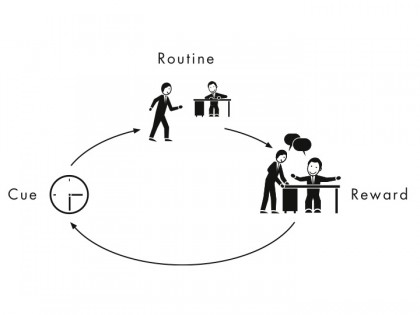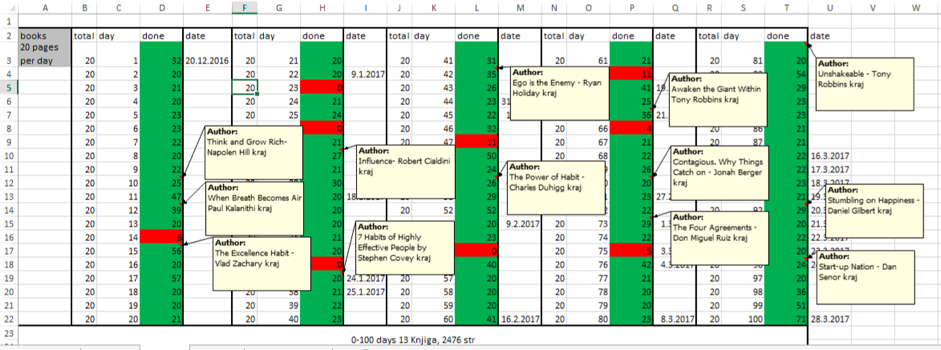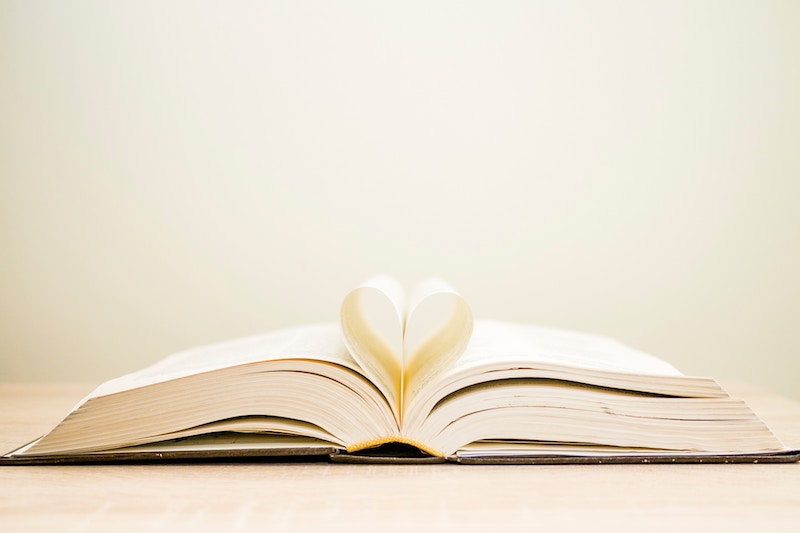Feature
The Proven and Easy Way to Read 47 Books A Year

Bruno Boksic
February 20, 2018
I was talking with my father the other day and we were discussing an event on TV. It was an interview with a famous person and the interviewer asked a tough question to which the famous person didn’t have an answer. At least, not a good one.
My father turned to me and, while pointing at the TV, said,“Son, you need to have the knowledge to prevent moments like this.”
“How am I supposed to do that?” I asked in return.
My father went to his bookshelf, took a book out and showed it to me saying, “Books, son, books. All the knowledge in the world is here and if you apply it, it will give you wisdom.”
That “other day” was more than 10 years ago, but that conversation really clicked in my head a year and a half ago when I started my book reading system.
__________
This system is divided into five sections that are crucial for building a great book reading habit.
We will talk about the way habits form and how they have a three-part structure. We will answer the age-old question concerning motivation and system – Which one gets us the results?
You will see my system and why I use tracking, measuring and red/green colours in Excel sheets. At the end, we will talk about consistency and quantity and why quantity almost doesn’t matter and the way you need to think about reading – not as something you do but as something you are.
1. How Habits Form
According to Charles Duhigg, the author of The Power of Habit, every single habit consists of 3 parts, which are, cue, routine, and reward. If you want to make reading a habit, you have to create a system which would have these 3 elements.
Cue
A cue is a trigger which sends a signal to our brain to start a certain task or operation. This cue can be internal or external.
An example of an internal cue: When you watch a game with your favourite football team playing and they have a penalty in the last minute, do you find yourself with your hand in your mouth for the entirety of the penal kick, biting your nails?
Your nervousness is an internal cue for a certain action, in this case, biting your nails.
External cues are triggered by our environment or other people. For example, when you are sitting in the car, it triggers you to either turn on the radio or the engine immediately. After enough repetitions, you do these activities automatically without even realising it.
My cue happens when I open my laptop because the e-book I’m reading is never closed. So when I open my laptop, the book just pops up, making it difficult for me to ignore.
Routine
When the cue triggers your brain, the activity that you do afterward is called a routine.
In the examples above, a routine would be biting your nails or turning on the engine. The routine doesn’t have to involve only a single action. There can be multiple activities tied into the same routine.
The routine with my book reading habit is just that – reading the book.
Reward
A reward is something positive you get from performing the routine which signals to the brain that you have taken action. If the reward is strong enough, the brain is primed to remember it for future uses.
My reward is the tracking system and the colour green (as explained later in the Part 3).
What does this mean for our reading habit?
It means that you should find a place and time to read and be consistent with it to form a reading habit.
(Image credit: Charles Duhigg)
2. Willpower vs. System
When I started my habit, I didn’t even realize how important the system is and how little willpower counts in the grand scheme of things.
Scientists have recently discovered that willpower is like a muscle and that it depletes with use. So the more you use it, the more it gets tired.
And if you have to use it excessively, it will deplete faster and it will be harder for you to follow through. That’s why you can’t avoid a cookie as a late night snack. To prevent this, we devise a system.
We only use our willpower to create a system and this system carries us later on.
A system is not only about the internal state, but also about the external state a.k.a. the environment. The environment plays a huge role in our behaviour so we need to be aware of that when we want to build a new habit.
If you want to read every single day, but your TV is on 24/7, then it will be much harder for you to actually read. Too many distractions nearby cause us to split our focus and lose more of our willpower.
If you want to adhere to your system, make it as a simple as possible to actually do it. Turn off the TV- even better, hide the remote control. Turn off the Wi-Fi, shut down all noise and keep your book within reach.
If the book is even 20 feet away from you, the task will be 10 times harder because you will need way more activation energy. That’s why you try to reach the remote control while sitting down, even though it is almost impossible. You would rather stretch in your chair as much as possible, assume weird positions and try to extend your arm as far as it can go than actually stand up and get the remote control.
That is what I am talking about. Keep the book near at hand and it will be easier for you to read.
To show you what a system actually looks like in real life, I will insert my book reading system which helped me read 47 books in a year.
2.1 My Reading System
Using all the above-mentioned information and research, and keeping the constant struggle of willpower vs. system in mind, I have managed to develop a simple, yet an effective system which helped me build my book-reading habit.
The book-reading system is a simple Excel sheet which consists of 4 rows.
Row A – Total: This is all about the goal I have for that day. In this case, my goal is to read a minimum of 20 pages of a book each and every single day.
Row B- Day: This is where I track how many days I’ve maintained my habit. I can clearly see which day of the habit it is today and it also helps me put my book- reading habit in perspective. It is a common misunderstanding that it takes 21 days of repetition to form a habit. It takes around 66 days to form a habit. And this row helps me see how much it will take me form the habit and how far I’ve come.
Row C- Done: This is about noting how many pages I read that day. If the number is 20 or more pages a day, the cell immediately turns green. If it’s 19 or less, it turns red. This way I have a visual overview of my habit and as a famous comedian once said “Get a calendar and write X on every single day you came up with a new joke. After a few days, you will get a chain. And when you get a chain, you will do everything you can not to break the chain.” So this is also a part of my reward system where I put the number, the cell goes green, and I acknowledge to myself that for that day, I did what I had to and it’s time to stop the activity.
Row D – Date: This is the current date and it gives me a calendar-based overview of my book-reading habit. Nobody lives in a vacuum and this row gives you the much-needed external perspective for your habit.
That is how my system looks graphically, but there is something hiding behind the surface and that is the reward system of the tracker.
3. Tracking and Measuring
What gets tracked, gets done. What gets measured, improves. As you can see in my system, I track and measure my reading on a daily basis.
When I created this tracker, I deliberately used an Excel sheet to keep it as simple as possible. I store the file on my desktop, right in the middle so there is no way I can miss the file if I use my laptop that day. That prevents me from not opening the file and adding up the numbers each and every single day.
Keep the tracker as simple as possible, and if it takes you more than 20 seconds to fill it, it is too complicated. It shouldn’t be another task that you need to do, but a helpful tool that provides the necessary data and a shot of dopamine as a reward when the green colour fills the cell.
So that is why you need to track your activity; but why do you need to measure it? For recognition and efficiency.
And to do that, we need to explore two ways we can measure almost any activity: 1) Time spent and 2)task done.
3.1 Time Spent
An average person reads 200 words-per-minute. An average page has around 250-300 words per page which means that it takes you 3 minutes for 2 pages of a book. If you read 30 minutes a day, that means you will read 20 pages in that time.
But this math is wrong. And it is wrong because you didn’t add up all the distractions in these 30 minutes.
What about the noise from the TV in the background which keeps distracting you, or the kids playing around the house, or the times when your mind wanders while you are reading?
Would you read Marcus Aurelius’ Meditations as fast as you read Fifty Shades of Grey?
When measuring time spent for reading, make sure that you add up extra time depending on the distractions around you.
3.2 Task Done
Fixed measuring means when you measure a percentage or a pre-decided number related to a certain activity. For book-reading, that is the number of pages that you read every day.
If you want to develop a habit of keeping your house clean, then the activity could be to “vacuum one room every single day“. That would be a way to measure a certain activity.
This way of measuring defines the activity you need to do and prevents you from ending the day until the task is done. If you stop at 10 pages a day, it means that your task for the day is not done.
This is the go-to way for measuring my performance for the reading habit and it works great.
But why only 20 pages? Why not more?
The age-old dilemma of consistency vs. quantity
(Image credit: Pexels)
4. Consistency vs. Quantity
So why only 20 pages a day? Why not 50, 70 or a 100 a day? I will answer this by giving you another example.
Let’s say you want to start vacuuming your house every single day and for that, you dedicate 5 hours each day. But one day come home from work, you are tired, cranky and just want to rest, but all the while the daunting task of spending 5 more hours cleaning the house is still niggling at the back of your mind. So you just give up because you don’t have 5 hours and even if you could manage to find 5 hours, it would just be too much.
Start with something small and you can later on work your way up. I chose 20 pages a day because it’s not too big of a task. It takes me around 40-60 min to read that much and no matter how busy I am, I will always find that much time to read those pages.
If I wanted to read 50 pages a day, it would take me more than 2 hours a day to do it, which is simply too long, causing me to skip it altogether.
That is why consistency is the key, especially in the beginning. You are forming a habit and it will feel a bit weird and awkward. But after a month or two, it will feel natural to take a book and start reading. Then, and only then, should you increase your daily routine if you want to.
I’ve stayed at 20 pages per day minimum and in a year it has accumulated to 47 books. If I had started with 50 pages a day, I wouldn’t have lasted more than 10 days and would have probably dropped the habit altogether.
There are days when I read just the required 20 pages a day, but also days when I sit down and just read for hours and hours, finishing 600-page books in 4 days. But if that was the norm, it would crush my habit right at the start.
Remember, every day that you read accumulates and at the end, you will have enormous results. But they come from small steps, not giant leaps.
But there is an effective way to cut that time in half.
5. I am vs. I do
When you look at your book-reading habit, is it something you do or something you are?
That is a critical piece which makes an enormous difference in the habit-building process. Because if you say “I am a bookworm” instead of just “I read books“, your entire mindset about books shifts.
When you are something, it is a part of your character and personality. It is deeply ingrained in you, a part of who you are and you can’t imagine your day without it.
When you do something, it is not a part of your personality or character, but simply a task that you are doing at a specific time.
You should think of yourself as Abhishek, 25, IT engineer, bookworm, and not Abhishek, 25, IT engineer, habits: enjoys reading books.
The effects of this kind of framing are widespread. Listen to how people represent themselves. They don’t write books, they are authors; they don’t do laps in the pool, they are swimmers; they don’t work in banks, they are bankers.
You can use the same effects in establishing your book reading habit. Ingrain it as a part of your personality and it will be easier to pick it up.
In this in-depth guide, we saw what lies behind building a successful book-reading habit.
We now understand how habits form and that they consist of cues, routines, and rewards.
The answer to the age-old question of motivation vs. a system was answered in the second part of the guide – we use motivation only to build a system and then, the system takes over.
I have shown you what my system looks like, what I use, how I track and measure it, and ultimately the dopamine shot I get when I don’t break the chain and mark the cell green.
To get there, you start small and focus on just showing up every single day – quantity doesn’t matter – at least not at this stage. And you saw the proof of that when a simple 20 pages a day accumulated into 47 books read in one year.
And at the end, you saw how to think about reading not as something you do, but as something you are. When it’s a part of your personality, you do it like your life depend on it.
I believe you can and will use this guide in establishing your reading system and that you will find yourself happy at the end of the year with many books under your belt.
All that is left is to implement it – one small step at a time.
What do you think of Bruno’s system to develop a habit of reading books? Do you have your own system?
Share with us in the comments.









Check your inbox to confirm your subscription
We hate spam as much as you hate spoilers!